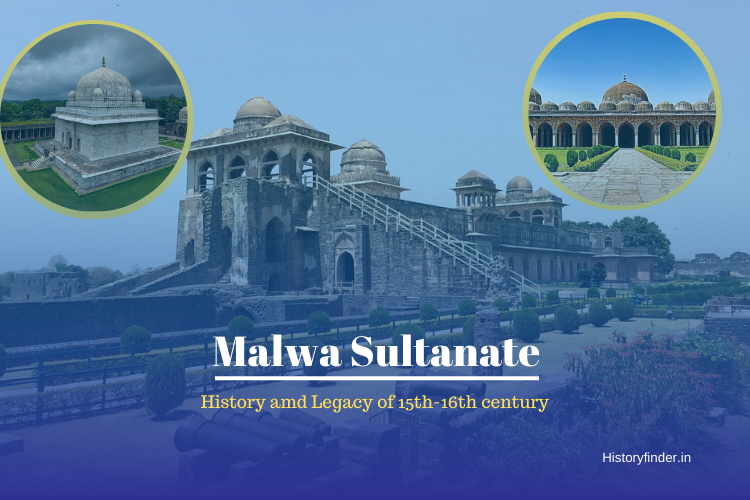Malwa Sultanate was a late medieval kingdom, notable for supreme legacy and glorious history. Politically, the kingdom of Malwa emerged as a strong independent state during late 14th century CE. Malwa being one of the most strategically important locations in medieval age, it came into several conflicts with nearby states. But despite of these odds, the sultans of Malwa made many remarkable contributions to Indian art and architecture.
Geographically, the region of medieval Malwa was formed with today’s Madhya Pradesh and south-eastern Rajasthan. The strategic importance of Malwa enhanced as a crucial junction to the trade route connecting northern and southern India. With the growing business, Malwa emerged as a vital administrative and military hub. The fertile lands of Malwa also had significant agricultural production, contributing in economic prosperity.
The legacy of Malwa sultanate was not only limited to art, architecture or economic development. But the sultans of Malwa kingdom were notable for their patronage to literature as well. The glorifying period of Malwa sultanate had produced many remarkable illustrative manuscripts. Historians and experts therefore see Malwa sultanate as a fascinating period of art, architecture, literature and romantic legends.
History of Malwa Sultanate: 15 Striking Facts
The period of Malwa Sultanate had a large contribution to the Indian history. Malwa region, until 1390 CE, had only been a part of Delhi Sultanate. But only in next few decades, the region emerged as a strong economical, political and military hub. Such an incredible transformation is bound to have some strange facts involved. Here I have discussed 15 such remarkable facts, that roams around Malwa sultanate history and its legacy.
1. Dilawar Khan Rebel Against Delhi Sultanate
Dilawar Khan Ghori, founder of Malwa sultanate, served the royal court of sultan Firoz Shah Tughlaq (1351-88 CE) at Delhi. He became extremely influential and hence powerful too. After Firoz Shah died in 1388 CE, Dilawar Khan supported his son Muhammad Shah to ascend the throne of Delhi. Ascending the throne of Delhi in 1390, Muhammad Shah promoted Dilawar Khan as the governor of Dhar, between 1390-91 CE. But Muhammad Shah’s reign was not more than a puppet rule at Delhi.
Since 1392 CE, Dilawar Khan Ghori stopped paying his tribute to Delhi. But interestingly, Dilawar Khan Ghori didn’t declare his independent government for another decade, despite provinces like Gujarat and Jaunpur did. But definitely, it was the first move of Dilawar Khan Ghori towards building the independent sultanate of Malwa.
2. Sheltering the Sultan of Delhi
Dilawar Khan, despite his silent rebel against Delhi, he had shown enough loyalty to the Sultan of Delhi. During the invasion of Timur in 1398 CE, Sultan Mahmud Shah Tughlaq sought shelter from Dilawar Khan Ghori. Historical accounts mention that Dilawar Khan Ghori welcomed him with open arms. He also supported Mahmud Shah on his campaign against Malik Sarwar, after the later declared Jaunpur an independent sultanate. However, the campaign against Jaunpur proved unsuccessful and Dilawar Khan Ghori had to retreat.
But the nobles of Delhi kept becoming powerful, especially the Sayyid dynasty. Sultan of Delhi eventually turned into a puppet ruler. Dilawar Khan realized the puppet rule at Delhi won’t do any good to him anymore.
3. Declaring Independent Malwa Sultanate
Seeing the political transformation at Delhi, in 1401 CE, Dilawar Khan Ghori declared his independent empire, Malwa Sultanate. The reign of Dilawar Khan Ghori, as a founder of Malwa Sultanate was very small. The move brought political stability across Malwa region, which earlier was part of weaker control under Delhi Sultanate. The reign of Dilawar Khan also marked the promotion of trade, urbanization and consolidation of administrative systems across Malwa.
4. Junaid Khan Ghori Took the Title of Hoshang Shah
Junaid Khan was the son of Dilawar Khan Ghori, later became popular as Malik Sanjar. He married the sister of Alauddin Khilji, the sultan of Delhi. Alauddin Khilji gave Junaid khan the title of Alp Khan, meaning the Powerful Khan. Nevertheless, Alp Khan ascended the throne of Malwa in 1406 CE. He then took title of Hoshang Shah, the name which became rather famous in the history of Malwa Sultanate.
The name Hoshang means ‘the promoter of culture and sedentary living’. Hoshang Shah, during his reign, indeed built a commendable culture across Malwa, making his own title worthy.
5. Relocation of Malwa Capital from Dhar to Mandu
Relocation of Malwa Sultanate capital from Dhar to Mandu (or, Mandav) certainly gave a strategic advantage to the kingdom. Dilawar Khan shifted the capital of Malwa from Dhar to Mandu in 1401 CE. But, he did not declare himself an independent sultan. Mandu became the official capital of Malwa Sultanate in 1406 CE, after Hoshang Shah became the first sultan of Malwa. Historians and scholars find several geographical, administrative, and geopolitical reasons for the relocation.
Geographically, Mandu was located on the plateau of Vindhya mountain range. Surrounding cliffs and deep ravines would make fortification much easier. Not only that, location of Mandu allowed better control over the trade routes, eventually led to the empire’s economic prosperity. Mandu being the epicenter of Malwa region added an administrative reason for relocating Malwa Sultanate capital from Dhar to Mandu. Higher altitude of Mandu also provided a much comfortable, pleasant weather with respect to Dhar.
6. Death of Dilawar Khan Ghori: Hoshang Shah Imprisoned
Dilawar Khan Ghori died in 1406 CE at Dhar. The death of Dilawar Khan seemed suspicious to Muzaffar Shah of Gujarat Sultanate. He immediately invaded Malwa, assuming Dilawar Khan was poisoned by his son Hoshang Shah. He defeated and imprisoned Hoshang. Later, on begging of Hoshang, he released him.
Hoshang Shah Ghori, released from jail, took the sultanate to its peak of glory.
7. Renaming Mandu as Shadiabad
The old city of Mandav (Mandu) consisted of lush green hills and valleys, rivers and lakes. The natural beauty of Mandu, especially during monsoon would please Hoshang Shah, the first sultan of Malwa. It certainly influenced Hoshang Shah to rename the city of Mandu as Shadiabad, the City of Joy. Sultan Hoshang Shah and his successive rulers of Malwa Sultanate took Mandu to its ultimate height. The city of Joy, Shadiabad, prospered in art, architecture and of course, in economy.
8. Fortification of Mandu
Hoshang Shah built Mandu as a formidable stronghold of Malwa which remained a crucial center of power for several centuries. The fort of Mandu was built by strengthening the existing fortress, Mandavgarh. Hoshang Shah encircled the entire plateau with massive defensive walls, over 45 kilometers of length. The Massive gates of Mandu fort were designed with tactical military precision. The Delhi Darwaza, Alamgir Darwaza, and Rampol Darwaza designs were effective enough in case of sieges. Hoshang Shah also ensured an uninterrupted water supply for the garrison and inhabitants. The integration of water systems consisting reservoirs, wells, and stepwells into the fortifications ensured sustainability during long sieges.
9. Establishment of Religious Tolerance at Malwa
Hoshang Shah Ghori, the first legitimate Muslim ruler of Malwa, promoted religious tolerance in the region. He built several mosques around Mandu, including Jami Masjid. On the other side, he invited Rajputs to settle in the region. It was undoubtedly the first sign of religious tolerance implemented by any Muslim ruler in India. The 15th century Lalitpur Temple inscription states that Hoshang Shah was enough supportive during construction of the temple. Jain community also received enough favor during the reign of Hoshang Shah Ghori.
10. Assassination of Mohammad Shah Ghori: Establishment of Khalji Dynasty
The death of Hoshang Shah (1435 CE), almost concluded Ghurid control over the kingdom of Malwa. Mohammad Shah, son of Hoshang Shah, eventually turned out to be the last Ghurid ruler of Malwa Sultanate. His incompetency as a ruler showed up quickly, during his very brief rule. In 1436, Mahmud Shah Khalji, the vizier of Malwa, assassinated Mohammad Shah Ghori. It commenced a new era in the history of Malwa Sultanate.
Mahmud Shah Khalji, the founder of Khalji dynasty at Malwa, engaged into many conflicts with Gujarat and Mewar. During his reign (1436-69), the kingdom of Malwa prospered significantly, especially in art and culture. Several illustrated manuscripts including Kalpa Sutra and Nimat Nama was prepared under patronage of Khilji dynasty. Mandu also prospered as the capital city of Malwa Sultanate.
11. Rivalries with Mewar and Gujarat
Sultan Mahmud Khalji had lifelong conflicts with Rana Kumbha of Mewar. The rivalry between Rana Kumbha and Sultan Mahmud Khalji began from sheltering Mahpa Panwar, who assassinated Rana Mokal. Rana Kumbha defeated and imprisoned Mahmud Khalji at the Battle of Sarangpur (1437 CE). He was kept in prison at Chittor Fort for six months before being released.
Mahmud Khalji fought for his revenge from Rana Kumbha. The battles of Mandalgarh and Banas (1442-46) was completely destructive for Mahmud Khilji. He captured Mandalgarh in 1456 but couldn’t keep it more than a year. His seize of Kumbhalgarh Fort in 1458 was a brave attempt but he had to retreat eventually. The Battle of Mewar (1467) was the last battle of Mahmud Khalji and Rana Kumbha rivalry.
Sultan Mahmud Khalji achieved comparatively more success against Gujarat. His invasions over western and southern Gujarat, especially Champaner, Bharuch, Baroda was very successful. Sultan Mahmud earned significant wealth from these campaigns. But he also faced strong resistance from Kapadvanj, Nagore and Sambhar.
Rivalries with Mewar and Gujarat cost Mahmud Khalji a lot more than gain. Although politically it didn’t favored Malwa that much but it has a great significance in the history of Malwa Sultanate.
12. Acquisition of Malwa by Gujarat Sultanate
Malwa Sultanate decline started during the reign of Sultan Mahmud Shah II. Sensing the opportunity, Sultan Bahadur Shah of Gujarat invaded Mandu. Malwa Sultan Mahmud Shah II surrendered to Bahadur Shah on 25th May, 1531. The acquisition of Mandu established the rule of Gujarat Sultanate at Malwa. As a result, Malwa became a province of Gujarat Sultanate.
Mughal Emperor Humayun invaded and captured Mandu fort in 1535. But within a year, Sultan Bahadur Shah regained Malwa from Mughal empire. Thereafter, Bahadur Shah had a stable rule at Malwa until 1542 CE.
13. Sur Conquest at Malwa
History of Malwa Sultanate had a twist with the conquest of Sur empire. Sher Shah Suri, the Sultan of Delhi, captured Mandu Fort in 1542. With the Sur conquest, Malwa now became a province of Delhi. Sultan Sher Shah Suri appointed his trusted Shuja’at Khan as the governor of Malwa. Sur dynasty’s realm at Malwa under Shuja’at Khan continued peacefully for a decade.
Sher Shah Suri was known for his efficient administration and military strategies. So, Sur conquest effectively introduced better administration and governance at Malwa. Taxation policies, and road networks (such as parts of the Grand Trunk Road) also thrived with Sur involvements. The Sur empire being highly dominant in northern India, it put a stoppage on frequent Rajput invasions on Malwa.
14. Restoration of Independent Sultanate of Malwa
Baz Bahadur, the son of Shuja’at Khan succeeded his father in 1555, as a governor of Malwa. Sur dynasty was already weakening then with the death of Hemu, at the Second Battle of Panipat. Baz Bahadur took the advantage and declared his independent government. Restoration of independent Malwa Sultanate thus lacks any military conflict.
But unfortunately, Sultan Baz Bahadur had no interest on strengthening his army. He was more involved in artworks. The romantic love story of Sultan Baz Bahadur and Queen Roopmati became famous legend of Malwa Sultanate. His passion for art and architecture produced few famous monuments at Mandu.
15. Acquisition of Malwa by the Mughals
Weakening military power of Malwa Sultanate, anyways was never enough to resist emerging power of Mughal empire. Mughal Emperor Akbar sent his foster brother Adam Khan to invade Malwa. On 29th March, 1561, Adam Khan led Mughal army defeated crushed Malwa army at the Battle of Sarangpur. Few historical accounts mention Adam Khan’s deep attraction over Rani Roopmati as the primary reason of Mughal invasion at Mandu. Nevertheless, the Mughal conquest of Malwa, eventually led to self poisoning of Rani Roopmati.
Baz Bahadur refuged to Khandesh and built a coalition with Khandesh and Berar Sultanate. Emperor Akbar also had recalled Adam Khan to Agra, leaving the command of Mandu on Pir Mohammad. When Pir Mohammad heard about the coalition is being made, he decided to attack Khandesh. But Baz Bahadur and his alleys defeated and killed Pir Mohammad. The victory let Baz Bahadur regain control of Malwa for the time being. But in 1562 CE, Mughal emperor Akbar sent another army under Abdullah Khan, which demolished Malwa army. Baz Bahadur refuged to Chittor and Malwa became a province of Mughal empire.
Legacy of Malwa Sultanate
Malwa Sultanate, the medieval kingdom of central India, was an important cultural and political center. The architectural advancements, literary contributions, and trade connections of Malwa Sultanate. Mandu, the capital of Malwa Sultanate, flourished as a center for Indo-Islamic architecture. Art and literature also flourished under patronage of the Sultans of Malwa.
Contribution of Malwa Architecture
Malwa Sultanate rulers left a great legacy through their architecture, producing a unique fusion of Persian and Central Asian cultures. Hoshang Shah being a patron of art and architecture, introduced a new architectural style that shines as Malwa architecture today.
The 15th century fort of Mandu is a classic representation of simple yet amazing architecture of Malwa Sultanate. Use of rubble masonry with plaster finishing, domes, arches, and massive gateways are few unique features of Malwa architecture. Integrating the structures with the natural undulating terrain of Malwa was another masterclass of architectural engineering.
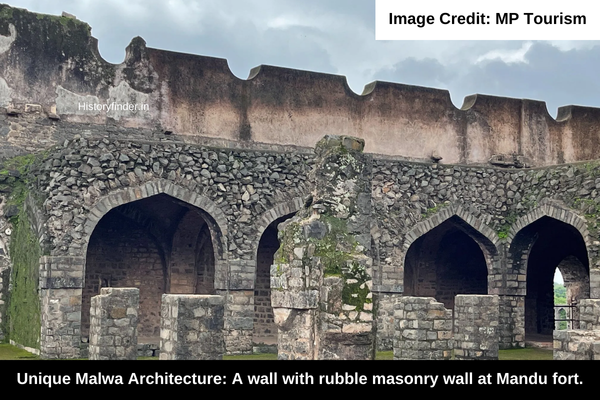
The rubble masonry walls, a salient feature of Malwa architecture, are visible at various places of Mandu fort. Jama Masjid of Mandu built by Sultan Hoshang Shah, is another classic representation of India’s top architectures of 15th century. The elegant domes and expansive structure manifests the simplicity and grandeur of Malwa architecture began in Ghurid era. The palace of Hoshang Shah was another architectural marvel of Mandu built by Sultan Hoshang Shah.
Mandu Fort
Hoshang Shah, the first Sultan of Malwa, constructed the Mandu Fort, over a ruined fortress. Mandu, the fortified city of Madhya Pradesh, is highly rich with many architectural gems and cultural heritages. The rampart encompasses myriads of palaces, mosques, temples and gateways. The breathtaking structures reflect greatest architectural heritage of Malwa Sultanate ever built in India.

Tomb of Hoshang Shah
The tomb of Sultan Hoshang Shah, however, is the pride and most beautiful architecture of Mandu. Built by Sultan Hoshang Shah himself, the eye catching structure features as the first marble tomb of India. Sultan Hoshang Shah, built his own tomb at Mandu, in 1440 CE.
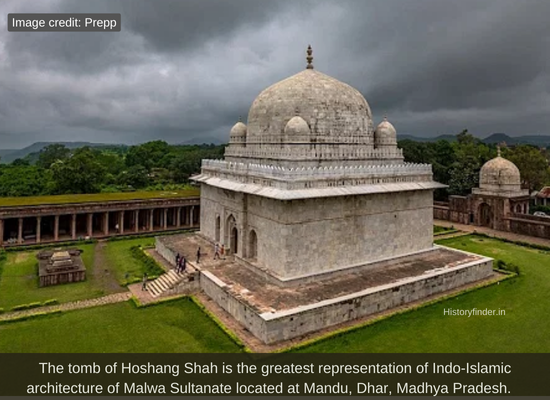
The first marble tomb of India hence bears the greatest legacy of Malwa Sultanate. Interestingly, the architecture of great Taj Mahal of Agra, was majorly influenced by the architecture of Hoshang Shah tomb. Mughal emperor Shah Jahan had sent his chief architect Ustad Hamid to examine the architectural elements of the structure.
Jami Masjid of Mandu
Jami Masjid is the famous historical structure of Mandu that connects two different dynasties that ruled independent sultanate of Malwa. An inscription mentions that Hoshang Shah began the construction of Jami Masjid of Mandu which Mahmud Khalji finished in 1454. The remarkable part is the architectural delicacy, which the two dynasties crafted their own way.
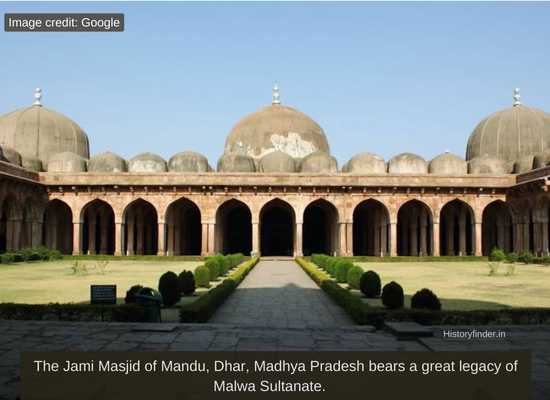
According to the eastern doorway inscriptions, Jami mosque, (or, Jama Masjid) of Mandu, was inspired from Umayyad Mosque of Damascus. The domes, arcaded chambers, and entrance gates, reflect many glimpses of west Asian Islamic architecture, perfectly blended with Indian architecture. The interiors of Jami mosque, also known as Jama Masjid, consists a plenty of artworks. The central mihrab has beautiful decorations with the verses of the Quran. The state that the design of Jama Masjid of Mandu was inspired from the Mosque of Damascus.
Palace of Rani Roopmati
Baz Bahadur, the last sultan of Malwa, was more renowned for his romantic nature. Rani Roopmati Palace features among the most beautiful structures of Mandu, reflecting the legendary Baz Bahadur and Roopmati love story. The pavilion of Rani Roopmati is the most attractive part of the palace. The fascinating view of Narmada river valley is the most alluring feature of the pavilion.
Rani Roopmati Mahal, the silent structure speaks about many tales about the legacy and history of Malwa Sultanate. The palace had symmetrical arches, reflecting the finest form of Afghan architecture blended with Indian style.
Rewa Kund
Sultan Baz Bahadur had built Rewa Kund as a dedicated reservoir to supply water at the Mahal of Rani Roopmati. Rewa Kund, another architectural marvel of Mandu, that reflects immense love of Sultan Baz Bahadur for his favorite consort.
Palace of Sultan Baz Bahadur
Baz Bahadur Mahal is among the most famous heritage monuments of Mandu. Built by Sultan Baz Bahadur himself, the 16th century structure is famous for its large courtyards. The large halls and high terraces are the most attractive part of Baz Bahadur Palace architecture. It creates a splendid view from Queen Roopmati’s Pavilion which mirrors their love story too.
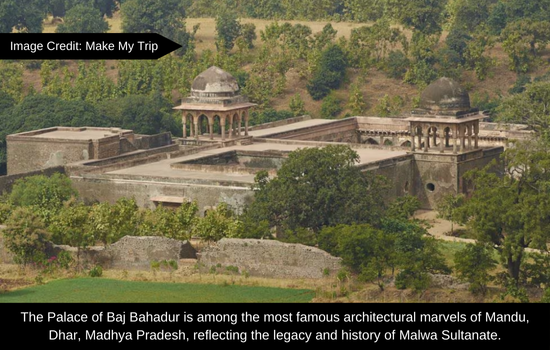
Rajput and Afghan architectures perfectly blend in Baz Bahadur Palace architecture. Sultan Baz Bahadur’s ‘Raga Deepak’, is a legendary story that makes the palace more interesting. His ‘Raga Deepak’ musical tune would light up all the palace lamps without any human intervention. Although the story has no historical evidence but the palace has enough significance exploring the history of Malwa Sultanate.
Tomb Complex of Darya Khan
The tomb complex of Darya Khan is yet another prominent heritage structure of Mandu, Madhya Pradesh. Darya Khan, a vizier of Malwa Sultanate (1510-26 CE), was extremely influential in the court of Mahmud Khalji II. Nevertheless, the walled tomb complex consisted of several structures including a mosque, a pond, and an inn. The tomb of Darya Khan is the massive sandstone structure, lying at the center of the complex.
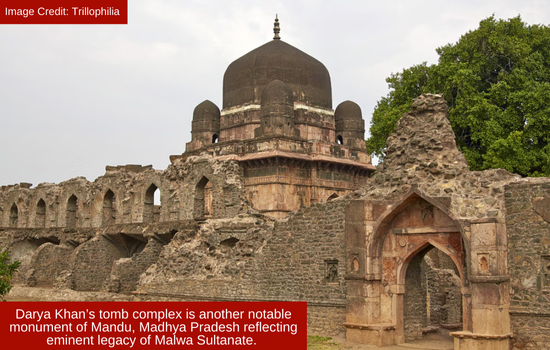
The sandstone tomb of Darya Khan has a very close resemblance with the spectacular marble tomb of Hoshang Shah. The ruined walls, entrance gate, the domes, all symbolize a simple yet fabulous architectural era. Hathi Paga Mahal few more notable structures in the complex, representing a glorious history of Malwa Sultanate. The palace was probably a pleasure palace. Hathi Paga Mahal, named after the elephant legs alike columns, appears on the south-eastern side of Darya Khan tomb complex.
Shri Mandavagadh Teerth
The original construction of Shri Mandavagadh Teerth of Mandu underwent an expansion during 14th century. The idol of Lord Suparshvanatha is believed to be much older. Apart from the idol of Lord Suparshvanatha, temple of Lord Shantinath also appears in the fort complex. Ruins of many temples and idols can be seen here. As per a reference once there were almost 700 Jain temples here.
Jahaz Mahal of Mandu
Architecturally, Jahaz Mahal or Ship Palace is among the most unique palaces in India. Situated between Kapoor and Munj Sagar lakes of Mandu, the two-storied palace indeed looks like a ship floating in water. Sultan Ghiyas-ud-din Khalji built Jahaz Mahal during 15th century, which served as his harem.
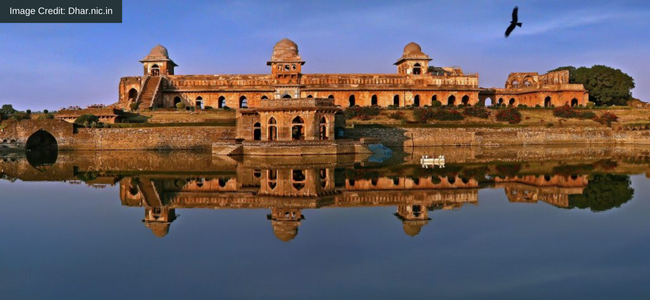
The architectural grandeur of Jahaz Mahal is rare in Indian history. It is the only monument in the vicinity that has plasters on its walls. Despite of partial collapse, Jahaz Mahal plays a significant role in Mandu festival every year. The impeccable monument has indeed left a great architectural legacy of Malwa Sultanate.
Hindola Mahal
Hindola Mahal was built by Hoshang Shah around 1425 CE. But few historical accounts differ, marking the palace as a 15th century construction, during the reign of Sultan Ghiyas al-Din. Architecturally, Hindola Mahal is also comes among the finest constructions within the royal palace complex of Mandu, Madhya Pradesh. The words Hindola Mahal, meaning swinging palace, was named after the sloping walls at 77 degree angle. Hindola Mahal probably had served as an audience chamber.
Malwa Sultanate left a great legacy through many of its architectural marvels. Taveli Mahal, and the Nahar Jharokha are few more fascinating constructions, built by the Sultans of Malwa.
Malwa as a Center of Art and Culture
Malwa, especially Mandu, emerged as a significantly large center of art and culture between 1400-1531 CE. The sultans of Malwa invited Hindu Rajputs to settle at Malwa. It allowed the proud culture of Rajasthan blend with Islamic Afghan culture to form an incredible culture at Malwa. Hoshang Shah and Mahmud Khalji were the great patrons of art, architecture and literature. Malwa art reflected in textiles, jewelries and several other craft works. Mandu, the capital of Malwa empire, flourished as a great learning center of literature during the era.
Malwa Paintings
Malwa paintings are the most beautiful legacy of Malwa art emerged under the patronage of the Sultans of Malwa. Kalpa Sutra (1439), a famous manuscript from Mahmud Khaji’s reigning period, originates from Mandu. Nimat Nama, a book about cooking, adorned with paintings of Ghiyas-ud-Din Shah is another interesting manuscript written during the time. Miftah-ul-Fuzala, a rare word dictionary, Bustan painted by Haji Mahmud, and Aja’ib-us-San’ati are few other notable manuscripts of the era. Anwar-i-Suhaili, another illustrative manuscript of same time, is now kept in the National Museum in Delhi.

Malwa Coins
Malwa Sultanate coinages are similar to the other Islamic coins featuring no pictorial representations but only the script. Hoshang Shah issued gold, silver and copper coins during his reign. His gold and silver tanka (unit currency) weighted around 11 grams. One side of his coins featured his name, Hoshang Shah Al-Sultan. The other side had the name of the mint, Dar Al-Mulk Shahdiabad.
Taj-ud-Din Muhammad Shah I issued coins in gold, silver, and copper in his rule between 1435 and 1436.
Ala Al-Din Mahmud Shah I had revolutionalized the Malwa Sultanate coinage system, by issuing several denominations. His gold coins had two denominations- One Tanka and Five Tanka. Silver coins, on the other side, had three denominations- One Tanka, Half Tanka, and One-Eighth Tanka.
